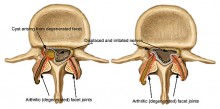Each vertebra in the spine joins its neighbour via three joints – the large disc in the front and two small facet joints behind, forming a triangle of joints surrounding the spinal canal.
The facet joints are most commonly affected by osteoarthritis (wear and tear arthritis). Facet joint pain can be felt over the affected joint but can also be referred – to the shoulder girdle, shoulder blade or arm in the case of the neck, or into the bony pelvis, hip or thigh in the case of the low back. It tends to be worse with extension of the spine (bending backwards).
Treatment Options
Physiotherapy and Medication
Local treatments, such as heat, ultrasound and massage may give rapid improvement of symptoms. Long term relief is obtained by strengthening the supporting spinal muscles of the neck or low back – this builds up the body’s own brace for the spine. See Physiotherapy.
This treatment may be complemented with anti-inflammatory drugs and analgesics.
Injection Therapy
Facet Joint Injections
These can be extremely helpful at relieving the pain caused by the arthritic facet joints. They also help to determine the source of the back pain and planning of future treatment. Cortisone and local anaesthetic is injected directly into the affected facet joints under X-ray control. This allows greater activity and enhances the treatment of the physiotherapist. See facet Joint Injection.
Radiofrequency Ablation
 If a facet joint injection is helpful, a much longer period of pain relief can be obtained by heating the nerves supplying the affected facet joint.
If a facet joint injection is helpful, a much longer period of pain relief can be obtained by heating the nerves supplying the affected facet joint.
Surgery
 Surgery is rarely used for pure facet joint disease and pain. Surgery is useful when facet joints develop osteophytes, (bony spurs) which, press on the spinal cord or nerves, usually affecting the lumbar or cervical spine. Lumbar decompression.
Surgery is rarely used for pure facet joint disease and pain. Surgery is useful when facet joints develop osteophytes, (bony spurs) which, press on the spinal cord or nerves, usually affecting the lumbar or cervical spine. Lumbar decompression.



